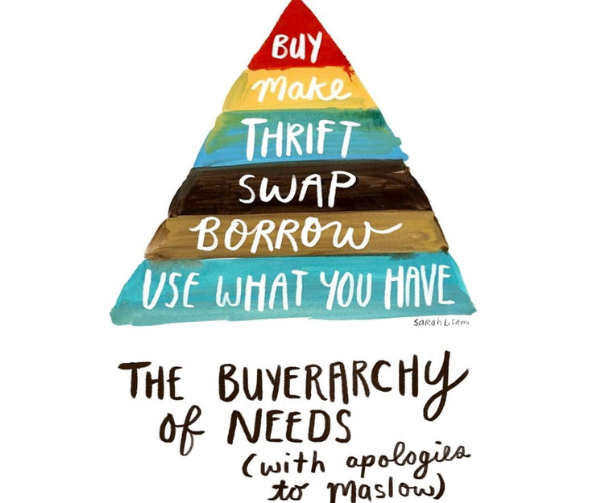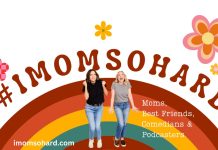It is that time again when the new school year looms. You can almost see the dollars evaporating from your purse. You write that list, hit the shops, and pay what’s necessary to get the job done. Or is it?
Whether you have one or multiple school-aged kiddies, back-to-school can be an expensive time of year. New clothes, backpacks, stationery, lunch boxes, and so on. The expense runs deeper than your pocket. The mass purchase and consumption of often short-term, single-use plastic items destined for the landfill also carries a heavy burden on the planet. You need a sustainable back-to-school guide!
It’s possible to reduce your consumption by using three of the R’s of the zero waste movement reduce, reuse, recycle! This year, let’s use more consideration to ensure a minimal environmental impact from your back-to-school preparations. Let this picture be your guide to purchasing (or not) this school year. Show it to the kids and discuss it as a family before heading off your shopping list.

Use what you have: What can be reused from last year, or handed down to a sibling? Raid your art supply cupboard, look in kitchen drawers, under beds, and shop your house. Reshape old pencils, revisit half-used notebooks, and treat your old backpack to a good scrub.
Borrow: Can you swap with siblings or friends to ensure everyone gets what they need? Check out your local ‘buy nothing’ Facebook group.
Thrift: We are spoiled in Portland with a large selection of consignment stores. What clothes or books can you buy used?
Make: Get crafty with a good DIY, or repurpose an item. Visit Scrap PDX for inspiration!
Buy: If all else fails and you need to buy it, here are some ideas on how to use your dollars to make better, sustainable choices for the environment:
1. Back Packs
It’s amazing what a good scrub and a cycle in the washing machine can do for an old backpack, but if you choose to buy new, consider investing in better quality. Those cheap, vinyl backpacks have short-term appeal, yet they will live on for hundreds of years in a landfill. Choose a long-lasting bag that is also kind to the environment. Buy from brands that prioritize sustainable, natural materials and fair trade manufacturing.
2. Stationary
While using what you already have is the preferred choice, if you need to purchase new, here are a couple of things to consider in low-waste stationary supplies:
- The life cycle of the product, its packaging, and the health/toxicity of the product. (Because little people like to cover their bodies in everything, and brushes and pens always seem to go in mouths.)
- The energy consumption and transport impact (buying local helps keep shipping costs minimal and reduces the carbon footprint).
To help produce minimal waste, try buying supplies in bulk direct from art stores, buy used, or buy only from earth-conscious companies who consider sustainable packaging and only use natural ingredients.
When your current supplies run out or need replacing, here are some great low-waste options to buy in bulk:
- 100% recycled paper for notebooks and journals with card covers
- Nontoxic tempura paint
- Wood-free colored pencils (just blocks of color)
- Wooden pencil highlighters
- Watercolor pencils, rather than plastic sets.
- Wooden paintbrushes
- Stainless steel pencil sharpeners, scissors, rulers, and staplers
- Chalk or charcoal (use slate boards instead of whiteboards and markers)
- Beeswax crayons
- Crayola has a recycling program available to K12 schools called ColorCycle, a sustainability initiative designed to repurpose all markers

3. Books
What kind of sustainable choices can you make with books? Does your school organize a yearly sale or book swap? Can you borrow or reuse from older siblings and friends? Browse one of the many great used bookstores Portland has to offer.
4. Lunch Boxes & Water Bottles
As visually and financially appealing as that cheap plastic box with your kid’s fave character is, it may not prove to be a good investment. You generally get what you pay for both in quality and materials used. Invest in one of the many eco-friendly options for all budgets:
- Stainless steel eliminates plastic usage and all those chemicals. We’ve been using planet boxes for years, and they are great for family picnics, too.
- Silicone bags for snacks are freezer friendly and dishwasher safe.
- Use cloth bags, compostable paper, or bees wax wraps for sandwiches and snacks.
- Try eco-friendly ice packs.
- Use glass containers.
- Try a Thermos for hot foods.
- Use a reusable water bottle for beverages.

5. Food
Though prepackaged snacks and drinks are an appealing way to save time before the school run hustle, single-use items are not only more expensive but also contain extra sugar, preservatives, and additives AND the packaging is often not recyclable. Consider packing your own snacks in reusable containers. Buy dried fruit in bulk, make homemade granola bars, and cut up fresh fruits and veggies.
Here are some great easy, quick homemade snack/lunch options
Explain to your kids why you’re making sustainable choices.
Making these changes is an excellent start, but it will go a longer way by using this opportunity to explain to your kiddies why these choices have a positive impact on our planet. Teach kids to look after and value what they have. We don’t live in a disposable world; items produced now will live on for hundreds of years once they leave your possession. Invest in items designed to be reused and create a circular economy.
Take the time to explain the impact plastic and toxic chemicals have on the environment. Most kids have a true affinity to nature and wildlife, and the realities of global plastic pollution may ignite your children’s interest in becoming sustainable, eco-warriors! This could lead to conversations about climate change or inspire your family to make other changes to reduce your waste!
In what ways does your family try to reduce waste? I would love to hear about your ideas/inspiration!
This article was originally published Aug 13, 2019

















